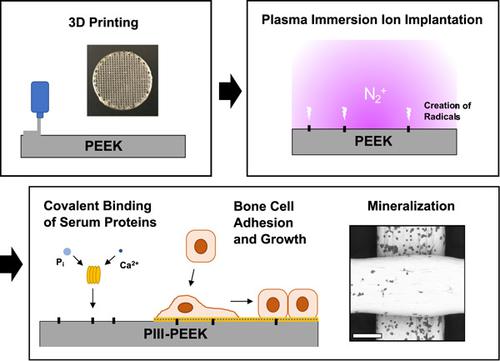当前位置:
X-MOL 学术
›
Plasma Processes Polym.
›
论文详情
Our official English website, www.x-mol.net, welcomes your
feedback! (Note: you will need to create a separate account there.)
Plasma ion implantation of 3D‐printed PEEK creates optimal host conditions for bone ongrowth and mineralisation
Plasma Processes and Polymers ( IF 2.9 ) Pub Date : 2021-01-19 , DOI: 10.1002/ppap.202000219 Hedi V. Kruse 1, 2 , David R. McKenzie 1, 2 , Jonathan R. Clark 3, 4, 5 , Natalka Suchowerska 1, 2
Plasma Processes and Polymers ( IF 2.9 ) Pub Date : 2021-01-19 , DOI: 10.1002/ppap.202000219 Hedi V. Kruse 1, 2 , David R. McKenzie 1, 2 , Jonathan R. Clark 3, 4, 5 , Natalka Suchowerska 1, 2
Affiliation

|
Polyether ether ketone (PEEK) is a three‐dimensional (3D)‐printable material with excellent mechanical properties for bone replacement implants. However, bioactivation is needed to improve its osseointegration. Plasma immersion ion implantation (PIII) provides PEEK surfaces with a high density of radicals, improving hydrophilicity and enabling covalent bonds with biological molecules. On the PIII‐treated surface, amorphous calcium phosphate‐associated protein depositions form a strongly bonded, mineralised layer during incubation in a cell culture medium. The strong adhesion is attributed to covalent linking of protein to the PEEK surface, which cannot be achieved by improved hydrophilicity or the introduction of functional groups alone. After 3D‐printed porous PEEK scaffolds were PIII‐treated, osteoblast‐like cell attachment increased by 8.8%, proliferation rate increased by 27% and mineralisation was enhanced, encouraging rapid osseointegration of patient‐specific implants.
中文翻译:

3D打印PEEK的等离子注入为骨骼长出和矿化创造了最佳宿主条件
聚醚醚酮(PEEK)是可三维(3D)打印的材料,具有出色的机械性能,可用于骨替代植入物。然而,需要生物活化来改善其骨整合。等离子体浸没离子注入(PIII)为PEEK表面提供了高密度的自由基,从而改善了亲水性并实现了与生物分子的共价键结合。在PIII处理过的表面上,在细胞培养基中孵育期间,无定形磷酸钙相关的蛋白质沉积形成了牢固结合的矿化层。牢固的粘附力归因于蛋白质与PEEK表面的共价连接,而这不能通过提高亲水性或单独引入官能团来实现。在对3D打印的多孔PEEK支架进行PIII处理后,成骨细胞样细胞附着增加了8.8%,
更新日期:2021-01-19
中文翻译:

3D打印PEEK的等离子注入为骨骼长出和矿化创造了最佳宿主条件
聚醚醚酮(PEEK)是可三维(3D)打印的材料,具有出色的机械性能,可用于骨替代植入物。然而,需要生物活化来改善其骨整合。等离子体浸没离子注入(PIII)为PEEK表面提供了高密度的自由基,从而改善了亲水性并实现了与生物分子的共价键结合。在PIII处理过的表面上,在细胞培养基中孵育期间,无定形磷酸钙相关的蛋白质沉积形成了牢固结合的矿化层。牢固的粘附力归因于蛋白质与PEEK表面的共价连接,而这不能通过提高亲水性或单独引入官能团来实现。在对3D打印的多孔PEEK支架进行PIII处理后,成骨细胞样细胞附着增加了8.8%,











































 京公网安备 11010802027423号
京公网安备 11010802027423号